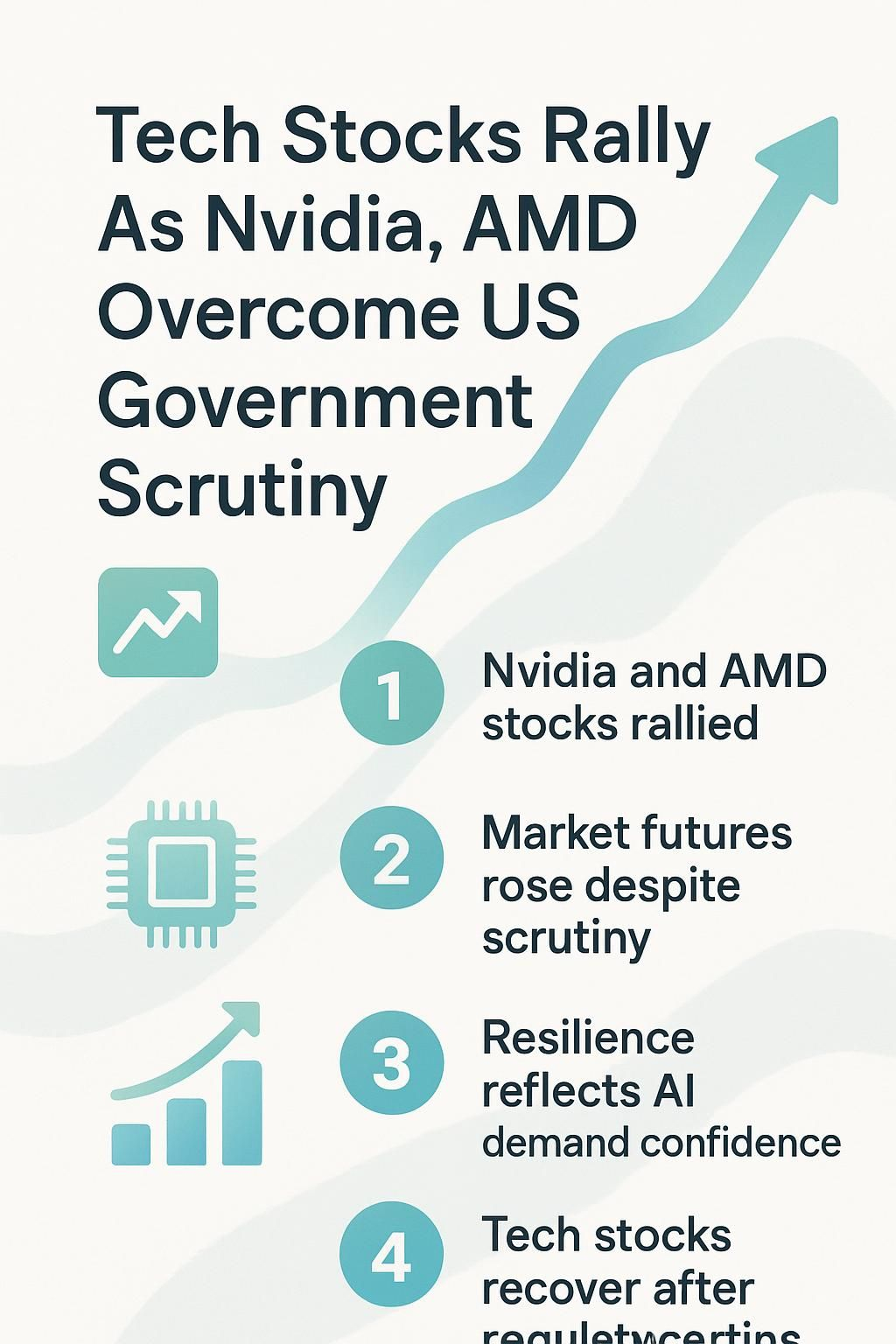Tech stock rallies occur when technology company shares experience significant price increases despite facing regulatory challenges. The semiconductor sector, led by major players Nvidia and AMD, has demonstrated remarkable resilience against government oversight concerns.
Futures rise despite US government shakedown of Nvidia, AMD, showing that investors maintain strong confidence in these companies’ long-term prospects. Both Nvidia and AMD serve as top producers of graphics processing units (GPUs) and hold significant influence over artificial intelligence and high-performance computing industries.
Market analysts observe diverse perspectives on this regulatory scrutiny, which centers on competitive practices, antitrust issues, and technological advancements that drive national interest in semiconductors.
Companies like Nvidia and AMD face heightened oversight, yet their stock performance tells a different story. CEOs and industry experts from both organizations express optimism about managing new regulations through proactive compliance strategies.
Historical patterns reveal that similar regulatory challenges typically result in brief stock dips followed by strong recoveries across the tech sector.
The broader implications extend beyond individual company performance to encompass investor sentiment, market stability, and innovation pipelines. Environmental and societal considerations also play a role, as these semiconductor companies contribute to advancing green technology and sustainable computing solutions.
Strong demand for AI-related products continues to drive bullish investor sentiment, with many prioritizing long-term growth over short-term regulatory risks. This market resilience tells a fascinating story about investor confidence.
Key Takeaways
- Nvidia and AMD stocks rallied despite intense US government scrutiny over their semiconductor operations and AI chip market dominance.
- Market futures rose as investors dismissed regulatory concerns, viewing government oversight as temporary hurdles rather than fundamental growth threats.
- Tech sector resilience reflects strong investor confidence in long-term AI and high-performance computing demand despite regulatory uncertainty.
- Historical patterns show tech companies typically recover from initial regulatory pressure, with temporary stock dips followed by strong recoveries.
- Industry leaders express optimism about navigating government regulations while maintaining innovation and growth in artificial intelligence technologies.

Market Response to Regulatory Scrutiny

Tech stocks have demonstrated remarkable resilience, with Nvidia and AMD shares climbing higher despite facing intense government scrutiny over their semiconductor operations. Market futures continue to surge as investors dismiss regulatory concerns, viewing the current oversight as a temporary hurdle rather than a fundamental threat to these AI chip manufacturers’ growth prospects.
Tech stocks, particularly Nvidia and AMD, have shown a rally despite facing scrutiny from the US government.
Nvidia and AMD stocks have defied expectations by surging higher despite intense regulatory scrutiny from federal authorities. Both semiconductor giants experienced notable rallies that caught many analysts off guard, especially given the heightened government oversight targeting their operations.
Market sentiment remained surprisingly positive as investors pushed share prices upward, demonstrating remarkable confidence in these tech sector bellwethers.
Stock market performance for both companies has shown impressive momentum even as regulatory concerns intensify. Investment professionals continue monitoring the situation closely, yet the upward trajectory persists across both stocks.
This rally represents broader tech sector trends, with Nvidia and AMD serving as key indicators of investor appetite for semiconductor investments during uncertain regulatory periods.
The article indicates that the market’s reaction has been positive, with futures rising even amidst regulatory challenges.
This rally extends beyond stock price movements into the futures market, where investors show strong confidence. Market futures have risen in response to tech sector developments, creating a positive sentiment that contrasts with expectations about regulatory pressure.
Trading volumes have increased as investors demonstrate their support for these semiconductor giants, viewing current challenges as temporary obstacles rather than permanent roadblocks.
Futures market performance acts as an indicator for sector health, and the numbers show market strength. Regulatory challenges have not significantly reduced overall investor enthusiasm, with analysts interpreting this resilience as a positive sign for long-term growth.
The tech sector continues to attract capital despite government scrutiny, reflecting investor confidence in the underlying demand growth for artificial intelligence and high-performance computing technologies.
Impact on Nvidia and AMD
Nvidia and AMD have demonstrated remarkable resilience in their stock performance, with both companies experiencing significant gains despite facing intense government scrutiny over their AI chip operations.
These semiconductor giants continue to attract investor confidence as their revenue streams from artificial intelligence applications remain strong, showing that market forces often override regulatory concerns in the technology sector.
Nvidia and AMD are significant players in the semiconductor industry, known for their production of graphics processing units (GPUs) and related technologies.
Nvidia and AMD dominate the semiconductor landscape through their cutting-edge graphics processing units and advanced computing technologies. These industry leaders manufacture hardware that powers everything from high-end gaming systems to artificial intelligence applications.
Their GPUs serve as the backbone for modern computing performance, driving innovation across multiple sectors. Both companies have established themselves as essential suppliers for the global tech economy, with their products setting industry benchmarks for reliability and technological advancement.
These semiconductor giants maintain a strong global presence in the tech hardware market, contributing significantly to both US and international economies. Their reputation for performance excellence has made them go-to choices for consumers and businesses seeking top-tier computing solutions.
The companies continue pushing technological boundaries, creating products that enable breakthrough innovations in gaming, professional graphics, and machine learning applications.
Their manufacturing expertise and research capabilities position them as key players shaping the future of digital technology and high-performance computing systems.
The article highlights the contrast between the companies’ market performances and the potential consequences of government oversight.
Nvidia and AMD continue to show strong market performance despite facing increased government oversight. Investor sentiment remains positive as both companies experience stock rallies, even while regulatory scrutiny intensifies.
This creates a stark contrast between current market gains and potential future compliance challenges that could impact operational freedom.
Analysts are weighing innovation benefits against oversight challenges as they assess long-term profitability prospects. Market gains may prove temporary if regulatory actions escalate beyond current levels.
The divergence between investor optimism and regulatory caution highlights the complex relationship between government policy and market performance in the semiconductor sector.
Reasons for Scrutiny
The US government’s scrutiny of Nvidia and AMD stems from concerns about their dominant position in the AI chips market and potential national security implications. Trade tensions have intensified as these semiconductor giants control critical technology that powers artificial intelligence systems across various industries.
The scrutiny from the US government may stem from concerns regarding competitive practices and technological advancements in the semiconductor sector.
US government oversight targets Nvidia and AMD over competitive practices that may harm fair market competition. Regulatory bodies examine how these semiconductor giants use their market dominance to potentially stifle smaller rivals.
Policymakers worry that rapid technological advancements by these firms create barriers for new companies trying to enter the market. Antitrust concerns focus on whether these companies abuse their position to control pricing and limit innovation from competitors.
Government scrutiny reflects broader national interests in maintaining a competitive semiconductor sector. Officials assess how technological breakthroughs by major players affect the balance between innovation and fair competition.
The strategic importance of semiconductors to national security adds another layer to regulatory oversight. This examination represents part of a wider trend affecting major technology companies across various sectors.
Investor Sentiment and Future Outlook
Investors remain optimistic about Nvidia and AMD’s growth potential despite regulatory challenges, with analysts pointing to surging demand for AI chips and high-performance computing solutions that continue to drive revenue expectations higher.
Market sentiment suggests these semiconductor giants possess the technological edge needed to maintain their competitive positions while adapting to evolving government oversight requirements.
Investors and analysts are closely monitoring the situation, assessing the impact of regulatory scrutiny on the companies’ future profitability and innovation.
Financial analysts track regulatory developments for potential impact on earnings across both companies. Market forecasts face revision due to regulatory uncertainty surrounding Nvidia and AMD’s operations.
Investment research now focuses heavily on regulatory risk mitigation strategies. Analyst commentary highlights both significant risks and emerging opportunities within the semiconductor sector.
Scrutiny of Nvidia and AMD’s innovation pipelines has intensified among market watchers. Growth potential remains a key consideration despite compliance challenges ahead. Profitability concerns center on the balance between compliance costs and profit margins under review.
Analyst insights suggest possible limitations on future expansion could affect long-term investment strategies.
The ongoing innovations and demand for high-performance computing and artificial intelligence applications are driving the interest in tech stocks.
While analysts assess regulatory impacts, market forces tell a different story about tech stock appeal. The ongoing innovations and demand for high-performance computing and artificial intelligence applications are driving the interest in tech stocks at unprecedented levels.
Nvidia and AMD stand at the forefront of technological innovation, investing heavily in research and development for next-generation products. Demand for high-performance computing is propelling tech stock valuations across the sector.
AI applications serve as a major catalyst for sector growth, with the market rewarding firms that maintain strong AI and computing portfolios. Future demand projections are influencing current investment patterns, as the tech sector’s growth becomes increasingly driven by AI-related products.
Investor interest remains closely tied to advancements in these fields, creating sustained momentum despite regulatory uncertainties.
Market Resilience and Confidence
Market resilience shines through as investors demonstrate unwavering confidence in Nvidia and AMD’s long-term growth potential, dismissing regulatory fears that could have derailed the semiconductor giants’ impressive stock performance.
This investor optimism reflects a deeper understanding of both companies’ strategic positions in the artificial intelligence and high-performance computing markets, where demand continues to surge despite government scrutiny and trade tensions affecting the broader technology sector.
The article suggests that market resilience demonstrates investor confidence in Nvidia and AMD’s long-term growth potential, despite regulatory fears.
Tech stocks continue to show remarkable stability despite ongoing government oversight. Nvidia and AMD have maintained rising stock prices, proving that investors prioritize long-term growth potential over short-term regulatory risks.
This resilience attracts new capital into the semiconductor sector, with bullish sentiment driving investment decisions across major trading platforms.
Confidence stems from expectations of continued innovation in artificial intelligence and high-performance computing applications. The sector’s proven track record of bouncing back from previous challenges reassures investors about future recovery prospects.
Both companies demonstrate their ability to withstand scrutiny while maintaining their competitive edge in graphics processing technology. This investor sentiment reflects deeper trust in the companies’ capacity to navigate regulatory hurdles while delivering consistent returns.
Industry Response
Tech industry leaders express confidence in their companies’ ability to navigate regulatory challenges while maintaining growth trajectories. Major semiconductor executives emphasize their commitment to working collaboratively with government agencies to address concerns while continuing to drive innovation in AI chips and advanced computing technologies.
Key figures in the tech sector, such as CEOs and industry experts, have expressed optimism about navigating government regulations effectively.
Tech industry leaders show strong confidence in their ability to handle new government rules. CEOs and industry experts have voiced optimism about working through regulatory challenges without major disruption.
Leadership teams across major companies are developing comprehensive strategies to ensure compliance with emerging policies. These executives believe their companies can adapt to new requirements while maintaining growth momentum.
Industry experts point to their sector’s proven track record of successful adaptation during previous regulatory shifts. Companies are focusing on constructive engagement with government officials to shape favorable policy outcomes.
Proactive communication efforts aim to reassure investors and stakeholders about long-term business stability. Collaborative initiatives between tech firms and regulators demonstrate the industry’s commitment to preserving both innovation and compliance standards.
Historical Context and Market Trends
Past regulatory challenges in the semiconductor industry have created predictable patterns where initial government scrutiny triggers temporary stock declines, followed by strong recoveries as companies demonstrate compliance and market fundamentals reassert themselves.
Nvidia and AMD’s current trajectory mirrors historical precedents from the 1990s and 2000s, when tech giants like Intel and Microsoft faced similar government oversight yet emerged with strengthened market positions and enhanced investor confidence.
Historical context may play a role in shaping current market sentiments, as previous regulatory challenges in the tech industry have led to temporary dips followed by recoveries.
Tech companies have faced government challenges before, and history shows a clear pattern. Previous regulatory battles created short-term market drops that gave way to strong recoveries.
Investors today look at these past episodes when they evaluate current risks. The industry’s track record of overcoming regulatory roadblocks supports confidence in long-term growth.
Market trends from earlier decades reveal that initial negative impacts often prove short-lived. Analysts use historical data to inform present-day forecasts about Nvidia and AMD’s resilience.
The sector’s history of innovation continues to fuel bullish sentiment among investors. Current market dynamics mirror similar past episodes where tech stocks bounced back after regulatory pressure eased.
Conclusion
The tech stocks rally demonstrates market confidence in Nvidia and AMD despite ongoing government scrutiny. Investors recognize the semiconductor industry’s critical role in artificial intelligence development and high-performance computing applications.
These companies show remarkable resilience, with stock performance reflecting long-term growth potential over short-term regulatory concerns. Market participants should monitor earnings reports and regulatory compliance updates to make informed investment decisions.
Smart investors who understand the balance between innovation demands and government oversight will position themselves for success in this dynamic technology sector.



